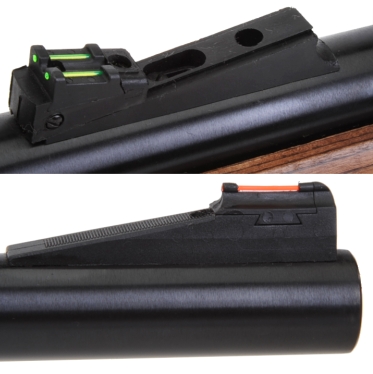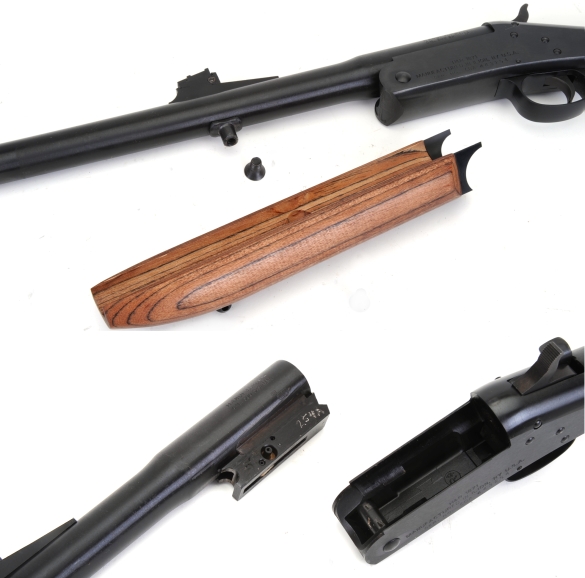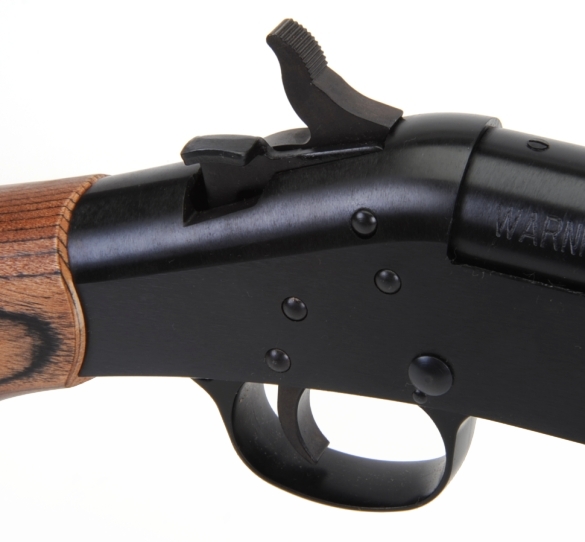
Initially, I didn’t know what to make of the H&R Handi-Rifle. It is a very basic rifle, shipped in very basic packaging. The first time I picked it up I couldn’t tell if it felt more like my old Savage 12 gauge break action shotgun, or a Thompson Center Contender or Encore. Above all, it is a single shot hunting rifle
|
H&R Handi-Rifle |
|
| Manufactured | Ilion, NY |
| Model# | SB2-500 |
| Type | Break Action |
| Caliber | 500 S&W Magnum |
| Capacity | 1 |
| Barrel Length | 22″ |
| Rifling | 1:18.75″ 8 Groove RH |
| Weight | 6 Lbs 12.5 Oz Actual |
| Overall Length | 38″ |
| Stock | Laminated Birch |
| Hardware | Blued Steel |
| Length of Pull | 14 1/4″ |
| Drop at comb | 7/8″ |
| Drop at heel* | 1 1/4“ |
| Sights | TruGlo Fiber Optic |
| Scope | Drilled and Tapped |
| Trigger Pull | 5 Lbs. 11 Oz. |
| Safety | Hammer Down – Transfer Bar |
| U.S. MSRP | $313.69 |
| – | |
Some of the details…

The TruGlo sights are a good choice for a hunting rifle, especially at short ranges where this rifle is intended to operate. The sight set has a range of adjustment significant enough to provide a useful range for cartridges with rainbow like trajectory. The 5/8″ – 7/8″ above barrel rear sight adjustment range provides about 60″ of elevation adjustment at 100 yards.
What’s up with all of that sight adjustment?
|
500 S&W Magnum 400 Grain Sierra JSP Rifle Load |
|||||||
| Range – Yards | 0 | 50 | 100 | 150 | 200 | 250 | 300 |
| Velocity – fps | 1750 | 1569 | 1408 | 1268 | 1155 | 1069 | 1005 |
| Energy – ft.-lbs. | 2720 | 2186 | 1760 | 1428 | 1185 | 1015 | 896 |
| Momentum – lbs-sec | 3.10 | 2.78 | 2.49 | 2.24 | 2.04 | 1.89 | 1.78 |
| Path – in. | -1.5 | 2.3 | 2.6 | -1.6 | -11.1 | -27.2 | -50.8 |
Even a casual 1,750 fps MV from a 22″ rifle barrel gives the 500 S&W Magnum some legs. In this case, at 300 yards the 500 S&W retains more kinetic energy and momentum than a factory 44 Magnum round generates at the muzzle. The table above represents a 137 yard zero and a 159 yard point blank range. If the rifle is to be shot at ranges 200 yards and beyond with this type of ammo and open sights, it would need that level of adjustment.
Big ol’ barrel…
The Handi-Rifle feels heavier than it is… probably a function of balance for the S&W 500 Magnum version. The barrel is 22″ long, 0.900″ at the muzzle and it weights 3 lbs 7 oz when free of the rest of the rifle. The wall thickness at the muzzle is 0.200″, which might seem a lot, but checking a rack of bolt action guns, rifles in 22 LR, 30-06 Springfield and 375 Ruger, wall thickness measured 0.187″, 0.205 and 0.198″ respectively. By comparison, a 22″ 30-06 Springfield barrel made for a Model 98 Mauser type action weighs 2 lbs 15 oz, which means the Handi-Rifle barrel is proportionally almost a lightweight for a .50 caliber. Didn’t see that coming until I got to the end of the paragraph.

Simple barrel removal… One screw out of the forearm, forearm removed, release lever depressed and the barrel is rotated down and off. The barrel is located to the breech by the hook on the barrel lug and the stout cross pin at the front of the receiver. For owners of Handi-Rifles produced after 2000, the rifle can be sent into H&R to have additional barrels fitted. Barrels are not sold separately for owner installation.
Optional barrels? Shotgun: .410/45 Colt combo, .410, 28 gauge, 20 gauge, 12 gauge, and 10 gauge in a number of lengths, both fixed and interchangeable chokes. Typical barrel cost is $58 with some of the special rifled and combo barrels in the $100 – $120 range. Rifle: 22 Hornet, 204 Ruger, 223 Rem, 22-250, 243 Win, 25-06, 270 Win, 280 Rem, 7mm-08 Rem, 30-30 Win, 30-06 Sprg, 308 Win, 35 Whelen, 357 Mag, 44 Mag, 45-70 Govt, 444 Marlin, 500 S&W in a variety of profiles and lengths, stainless and alloy steel. Price range is $101 – $120. Some applications are based on frame type, SB-1 or SB-2. Lastly, there is also a .50 caliber muzzle loader barrel. And you wondered why they are named Handi-Rifle.
H&R does a good job of explaining their accessory barrel program. There is the minor inconvenience of sending a frame back to H&R to have barrels fit and there is a small charge for the labor, $10 – $25 as defined by the program. Still, this makes the Handi-Rifle to handloaders and handload development what the old Contender use to be. For preliminary pressure, temperature and velocity recording work, the Handi-Rifle lends itself to mounting strain gauges and other data collection sensors. For hunters and recreational target shooters, this arrangement this takes a lot of cost out of trying to expand interests in different cartridges.
Not a lot of pictures to follow…
There is no bolt, slide or under lever to actuate the Handi-Rifle’s action not even the under lever and falling block of a Ruger No.1. This is a simple single shot where the barrel is hinged to the rifle’s breechblock with a barrel lug and stout pivot pin. The controls are limited to the hammer, which is also the firearm’s manual safety, and a release lever for lowering the barrel to load or eject.

The Handi-Rifle utilizes a transfer bar system. When the hammer is cocked in the aft position and the trigger is pulled, the rifle’s transfer bar is in the up position between the hammer and the rifle’s inertial firing pin. When the trigger is pulled, the hammer smacks the transfer bar, the transfer bar strikes the inertial firing pin and the firing pin strikes the cartridge’s primer. Instructions for setting the rifle’s safety are clearly and fully printed in the firearm’s manual and this is what should be followed. Essentially, the hammer resides in the down position with the transfer bar lowered so it cannot strike the firing pin. A rarity these days, H&R instructions advise not to dry fire the Handi-Rifle.
Issues and applications
Primary consumer interest in the Handi-Rifle appears to be price. However, with sub $300 bolt action rifles available from Marlin, Remington, Ruger, and Savage the logic may not be apparent. Low cost bolt action rifles are based on a one color jelly bean theory; make them all the same and make as many as possible. The impact of reduced inventory, reduced machine set up and commonality of materials pulls a lot of cost out of firearm manufacturing, which results in low cost firearms.

The similarly priced Handi-Rifle does just the opposite, it provides variety and flexibility and the option to change to something else in the future at only 1/3rd the cost of a new inexpensive firearm. It may be easy to find a bargain priced bolt action chambered for the 30-06 Springfield or 270 Winchester, but the 35 Whelen, 45-70 Gov’t, 444 Marlin, or 500 S&W Magnum? Not so much and, in most cases, interchangeable bolt action barrels are not part of the deal. We’ll get some ammo assembled and see how the Handi-Rifle performs.
Harrington & Richardson’s Handi-Rifle Part 1
Harrington & Richardson’s Handi-Rifle Part 2

Email Notification